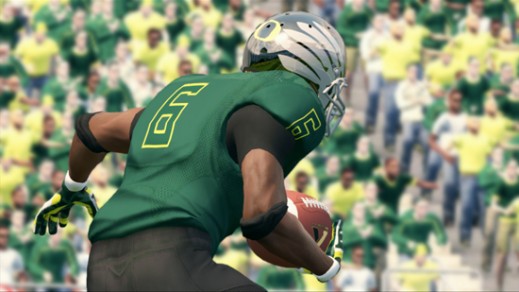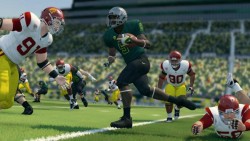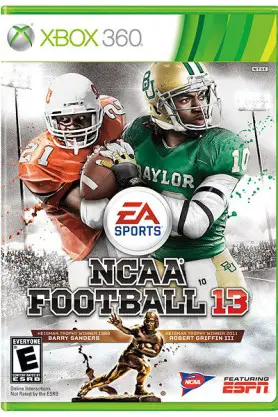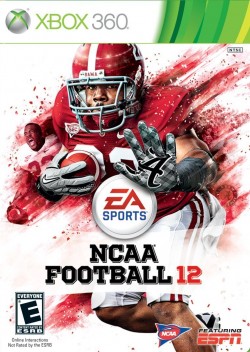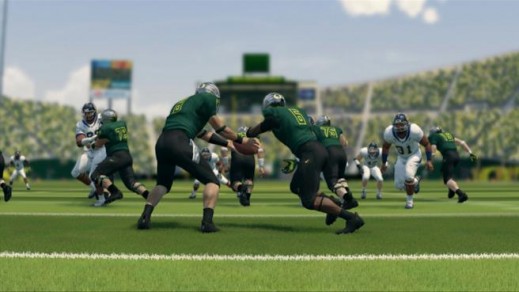In a long offseason, these are the slowest days. The sports world mirrors the working world: everyone’s on vacation, but when we check in, we find little going on.
For a sport with as much coverage as college football, the length of the season itself is quite short. To make the offseason more manageable, fans celebrate small milestones to break it up. From the bowl game, the season moves effortlessly into Signing Day. The spring football season nationally concludes with Oregon’s spring game, which has always been the Saturday halfway between the end of the bowl game and the start of the new season. Most fans follow other sports, allowing the NFL playoffs, March Madness, start of baseball, NBA Playoffs and the Stanley Cup to serve as effective distractions.
By this time of year, when few sports beyond regular season baseball are being played, it truly becomes the dog days of summer. Yet tomorrow, like the second Tuesday of every July, the newest edition of EA Sports’ NCAA Football franchise will be released, and the unofficial start to the new college football season arrives.
NCAA Football is our first chance as college football fans to play out the possibilities of a new season. With updated rosters for the upcoming season and players equipped with new ratings, we get our first chance to play out potential scenarios (in the most optimistic way possible, of course) for 2013.
While the game provides a fantastic outlet for the possibilities of the season, just how accurate have the ratings[1] been for Oregon before? I went back into past editions of NCAA Football to find out.
NCAA Football 13
Overall: 99 (A+)
Offense: 94 (A)
Defense: 95 (A)
The defense gets a lot of credit here, getting the same ranking as Alabama’s defense, and while Oregon fans certainly appreciate the designers giving the defense credit for the quality of its players rather than its statistical measurements (often misleading given the Duck defense’s number of plays per game), it was still a defense that finished 22nd in points per play and 25th in points per game.
We’ll say they made a defense that was good, a little bit better.
Meanwhile, the designers undersold the offense.
While it is hard to call any offense that is a 94 “underrated”, the 2012 version of Oregon’s offense in real life was arguably its best version yet. Instead, the designers set the Ducks’ offensive rating below teams like Arkansas (who finished 91st nationally in points per game) and USC (who was a 99, yet finished 7-6), and while this is likely attributable to predicted impact the designers figured the loss of LaMichael James (and his dreads) and Darron Thomas would have, they whiffed on the offensive rankings.
Oregon’s total ranking was a 99, tied for the highest ranking of any team in the game. That ranking itself fits, as Oregon ended last season in the argument for one of the best teams in college football, but it was still ranked fourth in-game, below both LSU (who ended the season ranked No. 14 in the polls) and USC (unranked).
Verdict: Slightly Underrated
NCAA Football 12
Overall: A
Offense: A+
Defense: B+
The grades may not hold much intrinsic value (beyond what we know about A-F grading systems), but comparing them to other schools gives a clearer picture. The rankings seem right: Oregon’s offense should just be an A+ or a 99 until further notice.
The defense, a quality unit who was statistically in the top quadrant of college football, was young on that side of the ball in 2011- replacing half the starters at the beginning of the season, and that was before having to replace the production of Cliff Harris and Anthony Gildon midway through their schedule for injuries or…otherwise.
Fittingly, Oregon’s in-game ranking (fifth) is below Stanford (A, A+, B+), who was ranked third, despite Oregon being given superior ratings in every category. This mirrored the public sentiment; that Stanford was the more publicly favored team all season (Oregon was a 2.5 point underdog going into the game), only for everyone to be reminded otherwise, as the Cardinal were blown out by 23 at home.
Still, Oregon’s ranking of fifth, where it stood at the end of the regular season, before finishing fourth overall is a negligible underrating, and seems about as close as designers can predict when putting rankings together months prior to the season.
Verdict: Properly Rated
NCAA Football 11
Overall: B+
Offense: A-
Defense: B+
In case you aren’t familiar with the NCAA Football series, the number in the title is a reference to the year following the season, not unlike the model year of a car.
I remind you of this because NCAA 11 is the game released prior to 2010, when the Ducks went undefeated and played for the National Championship. The designers clearly didn’t see that outcome ahead of time, deciding to give higher rankings to Florida (finished 8-5), Texas (5-7), USC (8-5) and Miami (7-6) instead. Miami’s offense was ranked an A while Oregon’s was an A-; Miami would finish 66th in scoring offense while Oregon led the nation in points.
Meanwhile other teams with the B+, A-, B+ ranking combination included Iowa (8-5), WV (9-4), Pitt (8-5) and sigh…Oregon State (5-7) and Washington (7-6), showing not much was expected from the Ducks that season. It would be easy to assume this was due to Jeremiah Masoli’s departure…except the totally-not-him-just-a-random-#8-QB is included in the game.
Instead, it seems more plausible that the game’s designers assumed Oregon’s 2009 campaign was a fluke and expected them to return to Earth the following season. Instead, Oregon played for a national title.
Verdict: Heavily Underrated
What does this mean for Oregon in NCAA Football 14?
Despite playing in a BCS game the previous season, each of the last three editions have Oregon underrated, anywhere from negligibly to heavily, from that upcoming season’s production.
This year’s game has the Ducks at a 95 overall, a 92 on defense and a shining 99 on offense. The only team ranked higher is Alabama, ranked 96 overall, while sharing Oregon’s 99 ranking on offense. Alabama’s offensive ranking seems particularly ambitious given that the Crimson Tide lost three All-American linemen to the NFL.
Still, there’s room for Oregon to be underrated again by the game, however slight that margin is, and that is a trend that Oregon fans can hope will continue for the 2013 season.
[1] Typically, team rankings are determined through an aggregate of the individual player rankings. If you want a cursory insight into how player ratings are calculated, this article will give you a start. (EA Tiburon handles both Madden and the NCAA Football series.)
ANNOUNCEMENTS
*Don’t miss our football analysis every Tuesday, our Recruiting Update every Wednesday and our new Chip Kelly updates every Friday!
*If you would like to join the other 80+ volunteers at FishDuck.com, and have five hours a week to donate…we have slots open for Editors, Writers, Analysts, Photo Archivists and Social Media Associates. Can you help us manage people? Consider our Sales Manager and Video Archive Manager positions. E-mail us at charles@fishduck.com
Related Articles:
Chip Kelly Update: Everything's Good Again ...
Chip Kelly Update: Wailing and Gnashing of Teeth
Shock and Awe -- The Oregon Ducks' Football Hangover Effect
Despite Lopsided Score, Georgia State "Never Stopped Believing"
Hope Springs Eternal for Ducks
Incompetent Pac-12 Officials: How Do You Miss ALL of THIS?
Nathan Roholt is a senior writer and managing editor emeritus for FishDuck. Follow him on Twitter @nathanroholt. Send questions/feedback/hatemail to nroholtfd@gmail.com.

